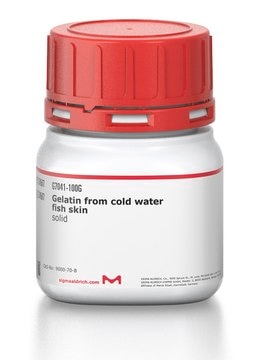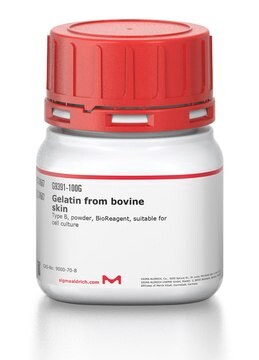935425
Gelatin from cold water fish skin
low endotoxin
Sign Into View Organizational & Contract Pricing
All Photos(1)
About This Item
UNSPSC Code:
51241857
NACRES:
NA.21
Recommended Products
Quality Level
form
powder (chunks or fibers)
impurities
<10 CFU/g Bioburden (fungal)
<10 CFU/g Bioburden (total aerobic)
125 EU/g Endotoxin
color
white to pale yellow
storage temp.
2-8°C
General description
Gelatin is widely used for tissue engineering and 3D Bioprinting applications. Gelatin is derived from natural extracellular matrix (ECM) components. Due to its low cost, abundance, and retention of natural cell binding motifs, gelatin has become a highly sought material for tissue engineering applications. While gelatin from porcine skin is known for its thermoreversible gelling properties, Gelatin from cold water fish skin has low gelling and melting points. This gelatin will not gel at 10°C, hence they do not have bloom strength. This unique gelatin property makes this an attractive biomaterial which are hindered by the higher thermogelation property of porcine skin such as vat-polymerization based bioprinting and microfluidics.
Application
- Hydrogels
- Tissue engineering
- Bioprinting
- Drug delivery system
Features and Benefits
- Naturally derived polymer
- Low gelling and melting points
- Thermoreversible gelling properties
- Low endotoxin and low bioburden
related product
Product No.
Description
Pricing
Storage Class Code
11 - Combustible Solids
WGK
nwg
Flash Point(F)
Not applicable
Flash Point(C)
Not applicable
Certificates of Analysis (COA)
Search for Certificates of Analysis (COA) by entering the products Lot/Batch Number. Lot and Batch Numbers can be found on a product’s label following the words ‘Lot’ or ‘Batch’.
Already Own This Product?
Find documentation for the products that you have recently purchased in the Document Library.
Svetlana R Derkach et al.
Polymers, 12(12) (2020-12-24)
This review considers the main properties of fish gelatin that determine its use in food technologies. A comparative analysis of the amino acid composition of gelatin from cold-water and warm-water fish species, in comparison with gelatin from mammals, which is
Hee Jeong Yoon et al.
PloS one, 11(10), e0163902-e0163902 (2016-10-11)
Gelatin methacryloyl (GelMA) is a versatile biomaterial that has been used in various biomedical fields. Thus far, however, GelMA is mostly obtained from mammalian sources, which are associated with a risk of transmission of diseases, such as mad cow disease
Our team of scientists has experience in all areas of research including Life Science, Material Science, Chemical Synthesis, Chromatography, Analytical and many others.
Contact Technical Service




